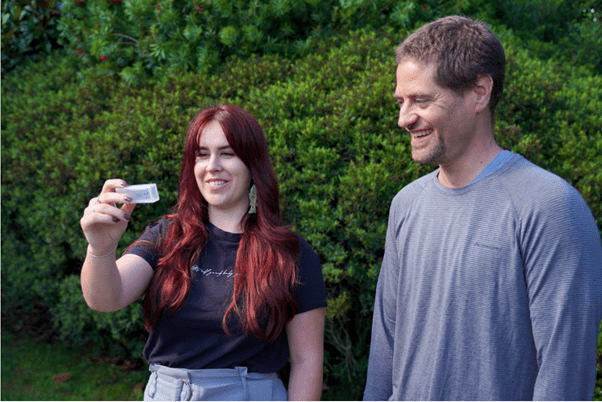Cawthron scholarship student uses fish ear bones and lasers to explore trout migration
24 February 2022
A “treasure trove” of fish ear bones at Cawthron has been the focus of a year-long study by an Otago University student whose work is revealing new secrets about feeding and migration habits of trout.
Cawthron Institute granted Ash Heaphy a $12k BSc Honours Scholarship – funded by donations from the New Zealand Professional Fishing Guides Association and a bequest by the late Brian Weatherhead – to support a project that could lead to improvements in freshwater fisheries management.
Ash grew up “just down the street” from Cawthron and attended Nelson College for Girls before completing an under-graduate degree (BAppSc) in agriculture and fisheries with a minor in marine science. She had “always wanted” to get into fisheries management and envisaged working at Cawthron “at some point” in her career.
Working under the supervision of Cawthron freshwater ecologist Robin Holmes and Otago University professor Gerry Closs, Ash recovered a large old box tucked away in storage at Cawthron that held books full of fish ear bones (otolith) slides previously collected by another Cawthron scientist, John Hayes.
Found in the inner ears of fish, otoliths grow like the rings of a tree and can provide a full record of a fish’s life, including their age, growth rate, diet and even the chemical signatures of the water they lived and travelled in.
Ash set to work transferring all the otoliths into a tiny little plastic container, no bigger than the palm of your hand. In doing so, she was able to use modern technologies to analysis the data they held to record the fishes’ migration habits. The process involves matching the chemical signatures found in each otolith growth ring with the signatures found in the waters of different parts of the catchment. In this way you can recreate the life history of each individual fish.
“The process of analysing is awesome because you’re shooting lasers at the bones in a machine so you can analyse the gas that’s created.”
Ash had hypothesised the big, fast-growing fish in the Pomahaka River, in South Otago, all migrated to sea for more plentiful food sources, but it turns out they were remaining in the river and accessing a different food source to the other smaller trout.
“One thing the last year has taught me about science is that you can have all these ideas about what’s going to happen and more often than not, you can be completely wrong.’’
Robin says Ash’s findings have implications for how fisheries and catchments might best be managed, and further highlights the importance of looking after river health.
“Her results show that anglers can’t necessary rely on the ‘sea-run’ trout to provide the big fish they are after.’’
Ash earned a First-Class Honours for her thesis from the project, and now has a unique set of knowledge and skills that can be applied to any fish species around the world. She is planning to embark on her PhD this year.
Meanwhile, Cawthon has entered a collaboration with Princeton University to expand on Ash’s findings. Princeton has the technology to identify what food the fish were eating though re-analysing the otoliths. This will provide an exciting scientific paper based on Ash’s findings, Robin says.
